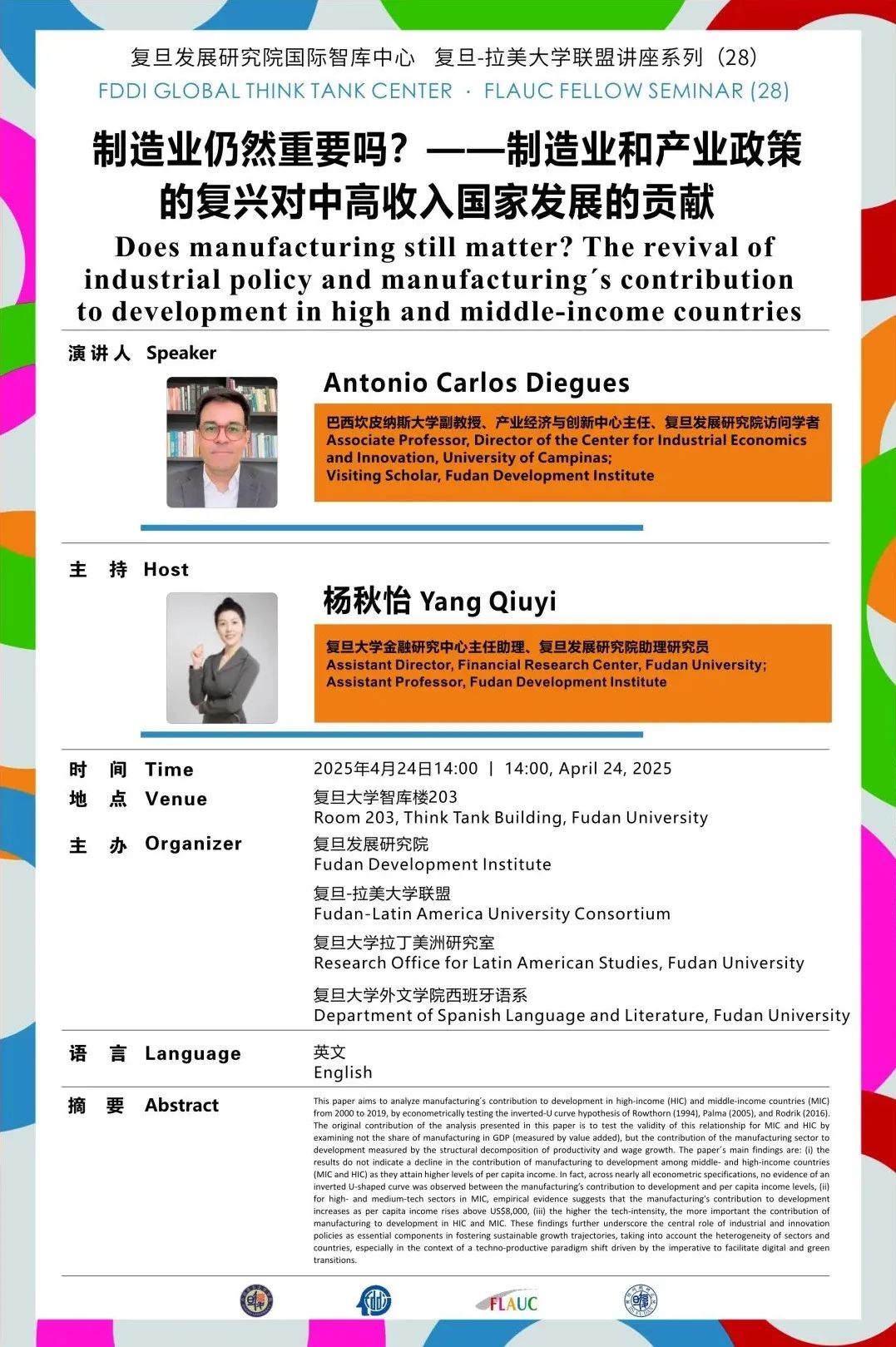作者:FDDI 发布时间:2025-04-20 来源:复旦发展研究院+收藏本文

主 题 / Title
制造业仍然重要吗?
——制造业和产业政策的复兴
对中高收入国家发展的贡献
Does manufacturing still matter? The revival of industrial policy and manufacturing´s contribution to development in high and middle-income countries
主 讲 / Speaker
Antonio Carlos Diegues
巴西坎皮纳斯大学副教授、
产业经济与创新中心主任
复旦发展研究院访问学者
Associate Professor, Director of the Center for Industrial Economics and Innovation, University of Campinas; Visiting Scholar, Fudan Development Institute
主 持 / Host
杨秋怡
Yang Qiuyi
复旦大学金融研究中心主任助理、
复旦发展研究院助理研究员
Assistant Director, Financial Research Center, Fudan University; Assistant Professor, Fudan Development Institute
时 间 / Time
2025年4月24日 14:00
14:00, April 24, 2025
地 点 / Venue
复旦大学智库楼203
Room 203, Think Tank Building,
Fudan University
主 办 / Organizer
复旦发展研究院
Fudan Development Institute
复旦-拉美大学联盟
Fudan-Latin America University Consortium
复旦大学拉丁美洲研究室
Research Office for Latin American Studies, Fudan University
复旦大学外文学院西班牙语系
Department of Spanish Language and Literature, Fudan University
语 言 / Language
英文
English
摘 要 / Abstract
本文旨在分析2000-2019年间制造业对高收入国家(HIC)和中等收入国家(MIC)发展的贡献,并采用计量经济学方法检验 Rowthorn (1994)、Palma (2005) 和 Rodrik (2016) 提出的倒 U 形假设。与现有研究不同,本文的创新在于并非使用制造业增加值占 GDP 的比重,而是通过对生产率和工资增长的结构性分解来衡量制造业对发展的贡献。主要发现如下:
1. 在几乎所有计量设定中,均未发现制造业对发展贡献随人均收入提升而下降的倒 U 形关系;
2. 在 MIC 的中高技术部门中,当人均收入超过 8,000 美元时,制造业对发展的贡献随收入提高而增强;
3. 技术密集度越高,制造业对 HIC 和 MIC 发展的贡献越显著。
这些结果进一步凸显了产业政策和创新政策在推动可持续增长路径中的核心作用,尤其在促进数字化与绿色转型所驱动的技术-生产范式变革背景下,更需考虑不同国家与行业的异质性。
This paper aims to analyze manufacturing´s contribution to development in high-income (HIC) and middle-income countries (MIC) from 2000 to 2019, by econometrically testing the inverted-U curve hypothesis of Rowthorn (1994), Palma (2005), and Rodrik (2016). The original contribution of the analysis presented in this paper is to test the validity of this relationship for MIC and HIC by examining not the share of manufacturing in GDP (measured by value added), but the contribution of the manufacturing sector to development measured by the structural decomposition of productivity and wage growth. The paper´s main findings are: (i) the results do not indicate a decline in the contribution of manufacturing to development among middle- and high-income countries (MIC and HIC) as they attain higher levels of per capita income. In fact, across nearly all econometric specifications, no evidence of an inverted U-shaped curve was observed between the manufacturing’s contribution to development and per capita income levels, (ii) for high- and medium-tech sectors in MIC, empirical evidence suggests that the manufacturing's contribution to development increases as per capita income rises above US$8,000, (iii) the higher the tech-intensity, the more important the contribution of manufacturing to development in HIC and MIC. These findings further underscore the central role of industrial and innovation policies as essential components in fostering sustainable growth trajectories, taking into account the heterogeneity of sectors and countries, especially in the context of a techno-productive paradigm shift driven by the imperative to facilitate digital and green transitions.